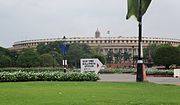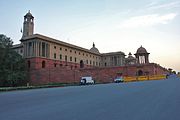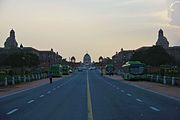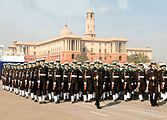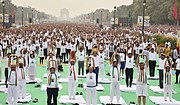Rajpath
Thank you for being part of the Bharatpedia family! 0% transparency: ₹0 raised out of ₹100,000 (0 supporter) |
Coordinates: 28°36′48″N 77°13′06″E / 28.613388°N 77.218397°E


Rajpath (formerly known as Kingsway) is a ceremonial boulevard in New Delhi, India, that runs from Rashtrapati Bhavan on Raisina Hill through Vijay Chowk and India Gate, National War Memorial to National Stadium, Delhi. The avenue is lined on both sides by huge lawns, canals and rows of trees. Considered to be one of the most important roads in India, it is where the annual Republic Day parade takes place on 26 January. Janpath (meaning "People's Way") crosses the road. Rajpath runs in east-west direction. Roads from Connaught Place, the financial centre of Delhi, run into Rajpath from north.
After climbing Raisina Hill, Rajpath is flanked by the North and South Blocks of the Secretariat Building. Finally it ends at the gates of Rashtrapati Bhavan. At Vijay Chowk it crosses Sansad Marg, and the Parliament House of India can be seen to the right when coming from the India Gate.
It is also used for the funeral processions of key political leaders of India. The opening scene of the movie Gandhi starts at Rajpath.
Name and history[edit]
In 1911 the British Imperial Government and the Viceregal administration determined that the capital of the British Indian Empire should be moved from Calcutta to Delhi. Accordingly, construction in that year began on the district of New Delhi, which would serve as the purpose-built administrative capital of the Indian Empire. The British Raj duly turned to Sir Edwin Lutyens to construct the new city. Lutyens conceived of a modern imperial city centred around a "ceremonial axis", such axis being the large boulevard now called the Rajpath. Lutyens wanted a panoramic view of the city of Delhi from the viceregal palace. Consequently, the view from Raisina Hill runs unhindered across Rajpath and the India Gate, and is obstructed only by the National Stadium.
Most of the buildings surrounding the Rajpath were designed by Lutyens and the second architect of the project, Sir Herbert Baker. The importance of such buildings in the government of India ensures the road's importance.
Name[edit]
When built the road was named King's Way, or Kingsway, in honour of the Emperor of India George V, who had visited Delhi during the Durbar of 1911, and where the Emperor formally proclaimed the decision to move the capital. The name was similar to Kingsway in London, which had been opened in 1905, and which was also a custom-built arterial road, and which had been named in honour of George V's father, Edward VII (as King of the United Kingdom).
Following the independence of India the road was given its Hindi name, 'Rajpath', in place of its English designation. This represents a mere translation more than a substantial renaming, since 'Rajpath' in Hindi is broadly analogous in meaning to 'King's Way'.
Under the Central Vista Redevelopment Project, the road has been referred to as 'Central Vista Avenue' in the media and government documents. However, its formal name of 'Rajpath' has not been changed.
Landmarks[edit]
- The Rashtrapati Bhavan, the official residence of the President of India. It was the Viceroy's residence before India got its independence from Britain.
- North Block and South Block, also called the Secretariat Building. North Block houses the offices of Finance and Home ministries. South Block hosts External affairs and Defense ministries. Other important offices like some of the Prime Ministers Offices are also in the Secretariat Buildings.
- Vijay Chowk (Hindi for Victory Square) is a spacious plaza and the site of Beating the Retreat ceremony, which takes place on 29 January each year, which marks the end of Republic Day celebrations, in which Military Bands, Pipes and Drums Bands, Buglers and Trumpeters from various Army Regiments besides bands of the Navy and Air Force take part, with the President of India as the Chief Guest.[1]
- India Gate is India's war memorial arch in honour of those who died in the First World War and the Second Anglo-Afghan War. It is also India's memorial of the unknown soldier.
- National War Memorial (India) -> Since Independence, more than 25,000 soldiers of the Indian Armed Forces have made the supreme sacrifice to defend the sovereignty and integrity of the country. It stands as testimony to the sacrifices made by the Indian Armed Forces during various conflicts, United Nations Operations, Humanitarian Assistance and Disaster Response Operations since Independence.
Redevelopment plan[edit]
In 2020, the Government of India planned a Rajpath redevelopment project which includes large scale stone work, construction of underpasses, underground amenities blocks and horticulture work on the three-km-long road, extending from India Gate to the Rashtrapati Bhavan.
On January 2021, Shapoorji Pallonji and Company Limited emerged as the lowest bidder for the Rajpath redevelopment project quoting ₹477.08 crore.[2][3]
On 4 February 2021, the Central Vista Avenue redevelopment project began. Housing and Urban Affairs Minister Hardeep Singh Puri performed bhoomi puja at the India Gate. It is scheduled to be completed in time for the Republic Day Parade in 2022.
The project includes refurbishment of the landscaping, increasing green cover from 3.5 lakh square metres to 3.9 lakh square metres, and a new irrigation system. Public toilets, drinking water facilities and a vending area will be constructed at 10 spots along the avenue. Underpasses at Janpath and a C-Hexagon crossing with Rajpath will be built.[4]
Gallery[edit]
Vijay Chowk at Rajpath, with Secretariat Building in the background, New Delhi, the venue of the Beat Retreat ceremony
North and South Block of the Secretariat Building illuminated
Sansad Bhavan - Parliament of India as seen from the Rajpath
North Block of the Secretariat Building seen from Rajpath
South Block of the Secretariat Building seen from Rajpath
Rashtrapati Bhavan seen from Rajpath
Indian Naval contingent marching on the Rajpath during Delhi Republic Day parade
A band performance at India's Beat Retreat ceremony at Vijay Chowk in 2018.
International Day of Yoga on 21 June 2018
References[edit]
- ↑ "Curtain Raiser – Beating Retreat Ceremony 2011". Ministry of Defence. 28 January 2011.
- ↑ https://www.financialexpress.com/infrastructure/central-vista-revamp-project-shapoorji-pallonji-emerges-as-lowest-bidder-for-rajpath-redevelopment-details/2166009/
- ↑ https://www.deccanherald.com/national/central-vista-shapoorji-pallonji-emerges-as-lowest-bidder-for-rajpath-redevelopment-935964.html
- ↑ https://www.thehindu.com/news/national/rajpath-redevelopment-project-begins/article33750092.ece




